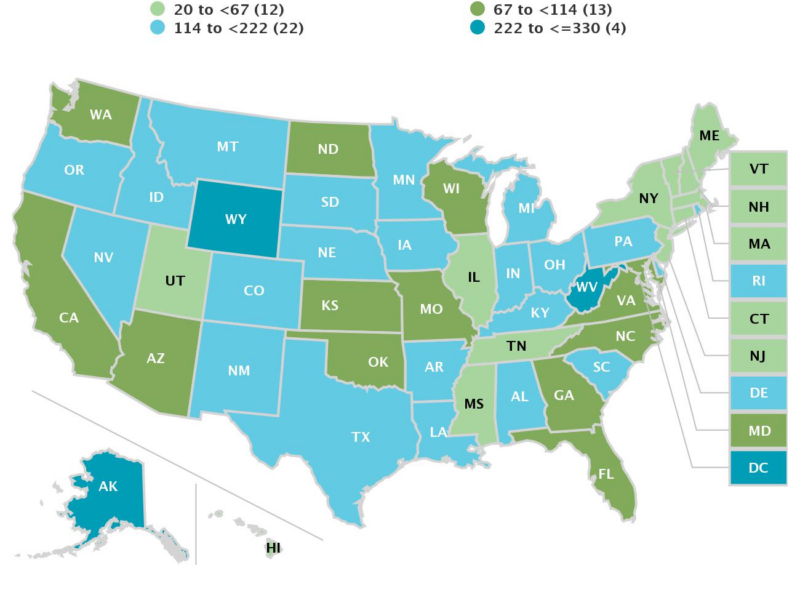House Passes Bill to Create Juvenile Justice Reporting System
Advocates: collecting data to shed light on Wyoming’s high youth incarceration rate
- Published In: Criminal Justice
- Last Updated: Feb 25, 2022

(Photo courtesy of the National Center for Juvenile Justice)
By Shen Wu Tan
Special to the Wyoming Truth
The state House has approved a bill that directs the Department of Family Services to create and standardize a statewide juvenile justice reporting system, which activists hope could shed light on Wyoming’s high youth incarceration rate.
Wyoming reported the fourth-highest juvenile incarceration rate in the United States in 2019, according to the latest Easy Access to the Census of Juveniles in Residential Placement report compiled by the National Center for Juvenile Justice, the research division of the National Council of Juvenile and Family Court Judges. The report says Wyoming incarcerated 239 out of every 100,000 juveniles, trailing Washington, D.C., (262 per 100,000), West Virginia (291 per 100,000 juveniles) and Alaska (330 per 100,000 juveniles).
“Youth advocates will tell you that the primary concern is Wyoming’s confinement rate – in that the Wyoming juvenile justice system places a disproportionate number of youth in out-of-home placements: detention, residential treatment centers, group homes, the Wyoming Girls School or the Wyoming Boys School,” Lindsey Schilling, senior social services administrator for the Wyoming Department of Family Services, told the Wyoming Truth.
House Bill 37 places the responsibility on the Wyoming Department of Family Services to collect juvenile justice data from any state agency or local government entity obliged to do so. The bill passed the House Wednesday with a 55-4 vote. It was introduced and referred to the Senate Judiciary Committee on Thursday.
In cases involving a juvenile who is convicted of an offense or adjudicated for a delinquent act, the department would be required to collect the juvenile offender’s name, social security number, date of birth, physical description and address of last known residence. The department would also have to gather data on the juvenile’s criminal offense, the juvenile court where the youth was adjudicated delinquent or convicted and information on the final disposition ordered by the court, including if the juvenile was committed to detention or treatment, ordered to serve probation or participate in an intensive supervision program, or held in pretrial detention.

“This is a monumental step in us being able to do an effective job reforming our juvenile justice system,” Donna Sheen, director and attorney for Wyoming Children’s Law Center, said about the bill at a Feb. 16 House Judiciary Committee meeting. “We need to understand what happens to youth within our system first and then be able to find out what interventions give us the best outcomes. And so, without this critical initial piece, we’ll have very little luck, I think, turning our system around… We continue to have very high youth confinement rates, which we believe, if we were doing a better job really identifying youth who need to be in placement, we could save the state millions of dollars, and so this is a first step in being able to identify those youth that need to be in confinement and avoid expensive confinement for those who can be better served with lower cost interventions in the community.”
The House also approved allocating $251,848 from the general fund for the Department of Family Services to fund a full-time position for data collection and related costs from July 1 through June 30, 2024. Legislators approved $450,000 from the general fund to the department to establish a computer program for data entry and collection for the same period.
Korin Schmidt, director of the Wyoming Department of Family Services, asked the House Judiciary Committee for some patience as the department works to set up the system for data collection. She also noted that the bill does not cover data from municipal courts, although it includes data from circuit courts and district courts.
Municipal courts, which run in some Wyoming incorporated cities and towns, handle ordinance violations but they don’t have civil jurisdiction. Municipal judges can hand down penalties of up to $750 and/or six months in jail. District courts are Wyoming’s trial courts of general jurisdiction. Circuit courts are considered limited jurisdiction courts, which includes all misdemeanor cases.
“Municipal court is really an important component of juvenile justice,” Schmidt told the committee. “Please don’t hear me advocating that I’d like to pull in all that data right now. However, I do think as we work through some of the logistics through the circuit court and district court that at some time having a conversation about municipal court data is going to be important.”
Schilling of the Wyoming Department of Family Services said including municipal courts was deliberated by the committee, but that the members acknowledged jurisdictional matters would need further review.
“It’s the hope that in the future, the system will collect data from municipal courts as well,” Schilling told the Wyoming Truth. “The department intends to initiate conversations with local municipalities to begin exploring options.”
The Wyoming Department of Family Services, the Wyoming Supreme Court and the Wyoming Survey & Analysis Center, a research department at the University of Wyoming, all have different methods for collecting data, making it difficult to track outcomes and determine how treatment approaches worked for juvenile offenders.
Under the bill, the Department of Family Services would have to report to the Joint Judiciary Interim Committee, comprised of members of both chambers, by no later than Oct. 15 to give an update about the “status of the transfer of responsibilities” under the act, such as progress on saving data for analysis. The department also would have to annually report to the committee by March 1 to provide an update on data collection and compliance.
The Department of Family Services would become the central authority for juvenile justice data, effective July 1, 2024.













